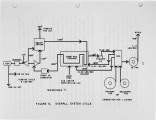| OCR Text |
Show 15 Design specifications for the Georgia lumber mill installation call for consumption of 612 pounds per hour of fuel with a lower heating value of 5270 Btu/lb on a wet basis with 45 % moisture - % moisture defined as 100 x (wet weight of sample - dry weight of sample)/(dry weight of sample). Start up fuel for the gas turbine combustor is preferably No.1 Diesel Fuel, and a flow rate of approximately 10 to 12 gallons per hour is required for the start up, electrical synchronization with the power grid, and operation of the fans and screw feeder to bring the fluid bed up to temperature. After the unit is running on biomass, the diesel fuel is cut off entirely, and so long as the unit is synchronized to a large grid, speed control is not required and the screw feeder will be controlled by turbine inlet temperature set point. ALTERNATE SYSTEMS AND CONSEQUENCES Although an optimized system for wood fuel has been presented, and the emission characteristics examined, it is by no means certain that this system is universal for all size ranges and all fuels. Fuels containing low melting point ash, such as rice hulls may require reduced temperatures to avoid the formation of "clinkers" in the bed, and glass deposits on the convective tubes. This would require that the turbine air leaving the furnace be at a reduced temperature, and thus the power turbine output would be reduced, unless the in line combustor were utilized with a premium fuel. This partially defeats the purpose of the biomass fueled system, but may still be a good solution, since the premium fuel could be used as a "topping" fuel whenever maximum power was required. Even with well behaved biomass fuels, high nickel alloys are required for the radiant furnace, and the higher temperature portion of the convective section. This may be an excellent application for the ceramic tube materials which are emerging from research and edging toward commercialization. Pressures are relatively low, and the temperatures are not extreme for ceramics. |




















